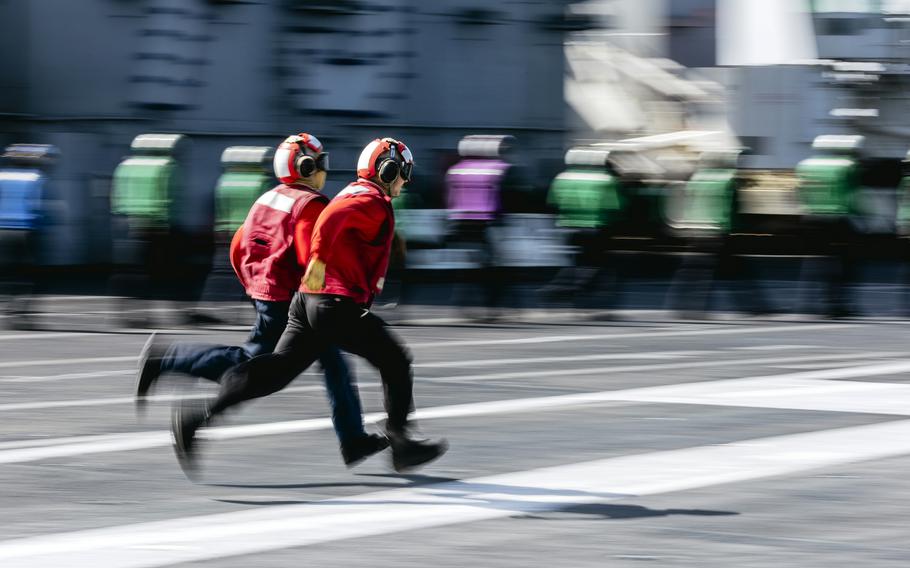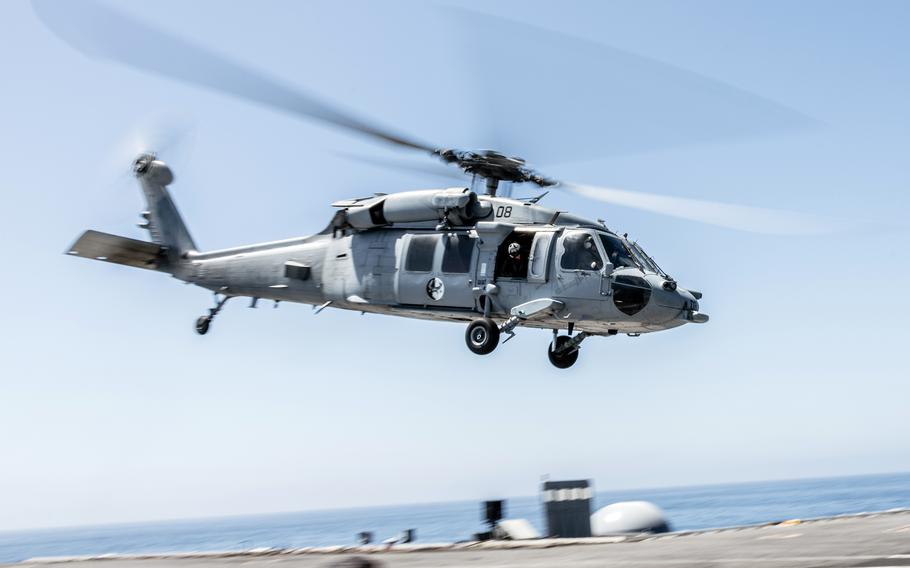
Petty Officer 3rd Class Israel Montano, front, and Airman Erick Telloayaca run on the flight deck of the aircraft carrier USS George Washington while underway in the Pacific Ocean, Aug. 25, 2024. (August Clawson/U.S. Navy)
The absence of a U.S. aircraft carrier in the Indo-Pacific poses no immediate risk to regional security but exposes the U.S. Navy’s inability to project a complete global presence, a defense expert told Stars and Stripes.
With the USS Ronald Reagan back in Washington state and its replacement, the USS George Washington, yet to deploy from San Diego, the 7th Fleet is temporarily without a carrier homeported at Yokosuka Naval Base, Japan.
“The lack of deployed carriers in the Pacific is not a security threat today,” Mark Cancian, a senior adviser at the Center for Strategic and International Studies, said by email Thursday. “However, it does mean that the U.S. has fewer tools available if a crisis or conflict occurs.”
The Pentagon on Aug. 2 ordered the aircraft carrier USS Abraham Lincoln, making its way across the Pacific, to relieve the USS Theodore Roosevelt in the Persian Gulf. Three weeks later, the Pentagon decided to keep both carriers and their strike groups in that area as conflict intensified between Israel and Lebanese militant group Hezbollah.
Meanwhile, the Ronald Reagan, operating from Japan for nearly a decade, returned to the United States for scheduled maintenance on Aug. 13.
Its replacement, the George Washington, began operations in the Eastern Pacific on Aug. 25, but was back in port at Naval Air Station North Island on Wednesday, according to information posted on the Defense Visual Information Distribution Service.
The U.S. 3rd Fleet did not respond to emails requesting comment on Wednesday and Friday.

An MH-60S Seahawk Helicopter takes off from the aircraft carrier USS George Washington while underway in the Pacific Ocean, Aug. 25, 2024. (August Clawson/U.S. Navy)
U.S. aircraft carriers have been a regular presence in the region since the USS Midway first deployed to Japan in 1973, but the current situation highlights the difficulty in projecting naval power on a global scale.
“Some strategists would have the United States withdraw from Europe and the Middle East to focus on the Pacific,” Cancian said. “That might be attractive in theory, but recent events in Ukraine and the Middle East show that it is just not possible.”
The Navy is too small to cover the Pacific, the Middle East and Europe simultaneously, Cancian added.
“It needs to be bigger,” he wrote.
The Navy is plagued with recruiting and manpower shortages, maintenance backlogs, delays in shipbuilding and a shrinking fleet, but hopes to grow its fleet from 296 to 381 ships over the next 30 years, according to an Aug. 8 report from the Congressional Research Service.
The Navy has declined to comment on when the George Washington would arrive at Yokosuka, but until then the Indo-Pacific isn’t completely exposed.
USS America, homeported at Sasebo Naval Base, and USS Boxer and their amphibious ready groups, as well as numerous guided-missile destroyers and cruisers, are in the area.
Those ships, along with allied military forces, demonstrate “our collective resolve to ensure security and stability in the region,” Pacific Fleet spokeswoman Lt. Cmdr. Christina Hough said by email Friday.
An amphibious ready group is typically composed of an amphibious assault ship, amphibious transport dock and a dock landing ship and carry more than 4,000 sailors and Marines and numerous aircraft, tanks and other vehicles.
The “large, powerful ships” show that the U.S. has not abandoned the region, and their capabilities are great for humanitarian assistance and the protection of U.S. facilities in the region, Cancian said.
However, they lack the “full range of combat power” of a carrier strike group, he wrote.
“In these situations, other forces are often tasked to cover portions of a [carrier strike group’s] missions,” Cancian added. “For example, the Air Force aircraft on Okinawa are likely tasked with providing some air defense and air striking power in the western Pacific.”